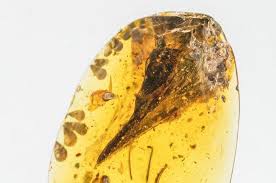
Everybody used to consider dinosaurs as giant lizards, yet researchers presently believe these animals were significantly more bird-like, and some of them were little. A new species of dinosaur has been found in Myanmar caught in a block of fossilized amber. This 99-million-year-old specimen was about the size of a bee hummingbird, making it the smallest known dinosaur.
The drop of ancient amber (fossilized tree sap) just contains the creature’s head, however, that is sufficient for researchers to affirm it didn’t originate from any previously known species of dinosaur. It has been named Oculudentavis khaungraae, and the group from the Chinese Academy of Sciences in Beijing trusts it would have possibly weighed around two grams when alive.
The fossil features a bird-like beak loaded up with various little, pointed teeth, oversized eye sockets, and the remaining parts of fine feathers on the head. Given its size and age, specialists trust Oculudentavis was undoubtedly a flying dinosaur. In any case, it’s different than modern birds. Its name signifies “eye tooth bird,” which educates people regarding its most defining features. Since everyone just has a head to go on, it’s difficult to decide how Oculudentavis may identify with modern birds. A few highlights fit intimately with other flying dinosaurs, and others are exceptional to Oculudentavis.
Given the toothy beak, the group studying Oculudentavis trusts it was a predator that went after small insects. In contrast to modern predators, Oculudentavis presumably didn’t have binocular vision. Birds have a ring of bones around the eye known as the scleral ring. These square-shaped bones help support the eye, yet the scleral bones in Oculudentavis are spoon-shaped. That is a characteristic just found in certain lizards today. This would have given Oculudentavis eyes that bulged out of the sides of its head. The enormous relative size of the eyes and the small pupils propose it was a daytime tracker too.
Its little size could be a reaction to advancing on an isolated island or maybe it developed to fill a quite certain ecological niche. CT scans of the amber have additionally uncovered the specimen could have some preserved soft tissue inside, perhaps remnants of the tongue. Examining that in more prominent detail could assist specialists with seeing how this animal identifies with modern birds and comprehend its place in the Cretaceous time.
Disclaimer: The views, suggestions, and opinions expressed here are the sole responsibility of the experts. No Opinion Bulletin journalist was involved in the writing and production of this article.



